MSRP: $59.98
RATED: NR
RUNNING TIME: 392 min
SPECIAL FEATURES:
• Multiple "Making Of" documentaries
• Multiple Fact Sheets
• Music Videos
• Interviews
• Never-before-seen bonus documentaries
• Multiple Photo Galleries
• Trailers
The Pitch
A breathtaking eight-part ocean opus.
The Humans
David Attenborough, Alastair Fothergill, "Bait Ball"

"What’s really amazing is that we’re the first people to ever scout this part of the ocean floor. Right now, we’re seeing what no one else has ever seen. Wait… what’s that? It looks like some kind of… writing… in the sand! I can barely make it out… It says… JAMES… CAMERON… WAS… HE- Oh, for Christin’ out loud!"
The Nutshell
BBC’s The Blue Planet, a documentary described as "the first ever comprehensive series on the natural history of the world’s oceans," tells the story of the ocean in eight parts: The Blue Planet, The Deep, Open Ocean, Frozen Seas, Seasonal Seas, Coral Seas, Tidal Seas, and Coasts. Each 50-minute segment focuses on a different aspect of the ocean’s ever-changing and diverse environment, and features a cast of characters that includes Blue whales, Spinner dolphins, Emperor penguins, Leopard seals, Cuttlefish, Sardines, Krill, Polar Bears, Coral, Manta Rays, Tube Worms, and deep sea horrors that will plague your dreams for weeks. There aren’t any sharks, so if you were interested in seeing those, go elsewhere. I’m kidding, of course- The Blue Planet is a shark bonanza.
The Lowdown
Making The Blue Planet must have been overwhelming. It isn’t like making a documentary about World War II or Jazz or some other nicely insulated topic- we’re talking about the FUCKING OCEAN here. It’s the world’s largest and most diverse habitat, and, according to various salty pundits and T.V. oceanographers, we’ve explored only .00000000000000000000001% of it. I can’t think of a more intimidating topic for a documentary to explore. Can BBC and the producers of the amazing Planet Earth documentary pull this one off? Well, if you’ve seen Planet Earth, it won’t be at all surprising to hear that Blue Planet is at least as good as its terrestrial cousin.
BBC scores another massive home run with The Blue Planet, as it’s simultaneously exhilarating, illuminating, beautiful, suspenseful, and entrancing. David Attenborough does a predictably wonderful job narrating the documentary (if you’re like me and have trouble identifying your Attenboroughs, that’s "Naturalist" Attenborough, as opposed to "Dinosaur Movie" Attenborough.), which is a lush, rich examination of the world’s oceans, and is probably the closest thing to a crash-course in oceanography as any of us might ever see.
DISC 1: Ocean World / Frozen Seas
Blue Planet starts off with an ocean "primer" of sorts in the Ocean World segment. It’s mostly a condensed, generalized highlight reel for the rest of the episodes, and it’s a pretty good way to open the series. There’s some great Blue whale material in this segment, as well. Since I didn’t watch Ocean World first, it wasn’t as useful to me as it could have been; however, if you’re debating whether or not you should buy the set, you could always netflix the first disc, as it’s a nice introduction. It leads right into one of the best segments in the set: Frozen Seas. Frozen Seas shows us the marine environments of both the Antarctic and Arctic, and spends a great deal of time looking at predator/prey relationships in these harsh, ice-covered worlds. The best part of Frozen Seas was a tense, cinematic standoff between a stranded pod of Belugas and a hungry Polar bear. The Belugas, trapped underneath a twenty-mile-long sheet of ice, have to rely on a single, eight-foot-wide hole above them for oxygen. Unfortunately, there’s a hungry Polar bear waiting for them at the edge of the hole, so each time they breach from the water to breathe, they risk getting plucked onto the ice by massive, ravenous bear-jaws. Amazingly, the bear does eventually manage to pull one of the whales out of the hole, and gets a full ton of meat for its troubles. Merry Christmas! Frozen Seas also spends time following both Chinstrap and Emperor penguins in the Antarctic. Thankfully, it doesn’t cover any of March of the Penguins‘ territory, as it’s mostly concerned with showing the penguins’ uneasy relationship with the Leopard seal. Frozen Seas is one of the better segments since it’s so different from any of the other topics, and also because it features a WHALE-EATING BEAR.
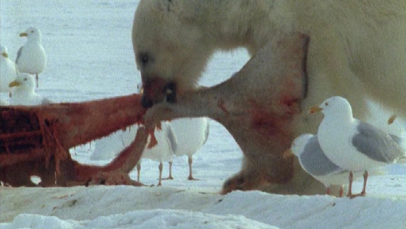
I just pulled a 2,000 pound whale out of the sea with my bare hands. What did you do today?
DISC 2: Open Ocean / The Deep
Disc 2 starts with a look at the vast "marine deserts" of the open ocean. Since most aquatic life tends to stick close to the shoreline, there isn’t as much diversity in the open ocean, but Blue Planet was still able to ferret out some amazing footage. This segment is extra special because it’s the first to show the "Bait Ball" phenomenon. For those who are unaware, a "Bait Ball" is a swirling, writhing, seemingly sentient defensive orb created by a frantic school of fish. It resembles a real-life herd of squid-bots from The Matrix: Revolutions, and is one of the coolest things you’ll ever see. We also get to watch migrating tuna, undersea volcanoes, and a swarm of hammerheads. Next, The Deep goes head-on into James Cameron territory as we explore the mysterious ocean bottom. The Deep was my favorite of all of the segments. It’s an undersea house of horrors, from the menacing anglerfish to the eerie, wide-mouthed gulper eel. Warning: these Lovecraftian beasts might make you question your sanity. DON’T LOOK AT THE IMAGE BELOW!
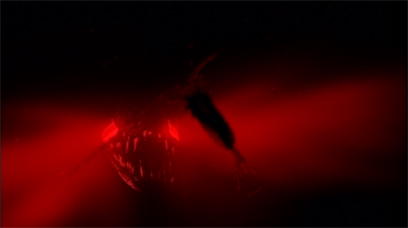
This shrimp is about to get his or her ass kicked.
DISC 3: Tidal Seas / Coasts
Tidal Seas was another one of the documentary’s most unique segments. So much interesting stuff happens where the ocean meets the land, and Tidal Seas really capitalizes on that. This segment is crustacean-infested, as it follows sand bubbler crabs, shellfish, bone shrimps, and other possibly delicious animals. Tidal Seas also features Raccoon versus Crab, which is almost as good as Bear versus Whale. Don’t miss it. Coasts, detailing "the most dynamic" of the ocean’s environments, is also a lot of fun. We spend a lot of time on the always fascinating volcanic islands of Galapagos, and we travel to the cold seas of Russia to follow vast, thousands-strong herds of elephant seals. The great battle between these seals and hungry Orcas is often hard to watch, as Orcas like to play with their food.

Since the Fisher-Price jellyfish lives in total darkness, it requires 6 AA batteries to survive.
DISC 4: Seasonal Seas / Coral Seas
These two segments are a bit more "intimate" than the rest. It seems like they’re both super-focused on reproduction, which is fine- there’s nothing wrong with that- it’s just odd that they seemed to save all the sex stuff for the last disc. Seasonal Seas takes a look at the effect changing weather has on the ocean. It’s good, but it’s my least favorite of the bunch. It seems to meander more lazily than the other segments, and doesn’t seem to feature as many interesting moments. Coral Seas, the final segment in the feature, is a look at life within the coral reef, and was one of my favorites. Since there’s such a wide array of life within the reef ecosystem, we’re treated to a smorgasbord of great moments, like reef shark feeding frenzies, cuttlefish light shows, and REEF WAR™ (I coined the term REEF WAR, which is what happens when two rival coral colonies go to battle. They attempt to digest each other by vomiting on their rivals, Goldblum-style!). It’s a great way to end the series. Oh, and if you were ever wondering what reef sperm looks like, here you go:

The ocean’s money shot.
Fascinating, but gross!
The bonus disc is a hodgepodge of material that didn’t make the final cut. There’s a lot of shark footage here, so it’s definitely worth a look if you didn’t get your shark fix over the last eight hours. Additional topics include Amazon Abyss, Dive to Shark Volcano, Being There: Antarctica, and Being There: Between the Tides. Be warned- they’re not narrated by Attenborough, and they’re not as good as The Blue Planet‘s "canon" material, but it’s a pretty decent extra four hours of material.
The Blue Planet is a remarkable achievement. Its production single-handedly revealed the migratory habits of the Blue whale. Multiple species of deep sea creatures were discovered during Planet‘s journey into the deep. It’s easy to feel dwarfed by the spectacular array of life that surrounds our tiny cluster of continents on earth. As Blue Planet does a great job of encapsulating this environment into an eight-hour package, I highly recommend this.
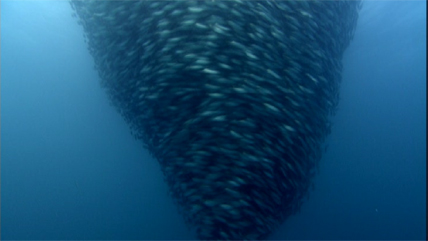
Unfortunately for the Donaldsons, their home was not insured for damaged caused by Fish Tornadoes.
The Package
Blue Planet has tons of bonus features like music videos, interviews with the filmmakers (it turns out that the cameraman was almost eaten by a Polar bear), and multiple making-of documentaries. There are also picture galleries, trailers, and fact sheets on each disc. There’s just so many hours of stuff on these five discs that you’ll probably have your hands full for quite some time.
My main gripe with The Blue Planet? The audio. George Fenton’s lavish score deserves better than this unimpressive Dolby 2/0 track. I’m aware that Blue Planet preceded Planet Earth, but the audio could have really used an update for this new release. The video is great, although a few of the underwater scenes seem quite murky. Plankton can be obnoxious.
The box art is pretty standard for an ocean documentary. It’s a high-quality folding-style package that seems to be the norm these days, although I hope we eventually move away from this style and go towards the individually-packaged ‘boxes within a box’ that the Seinfeld sets are pioneering. I’m just tired of all the folding going on over here. It’s not a gripe so much as it’s a wish for future box sets to follow Seinfeld’s lead.
9.0 out of 10
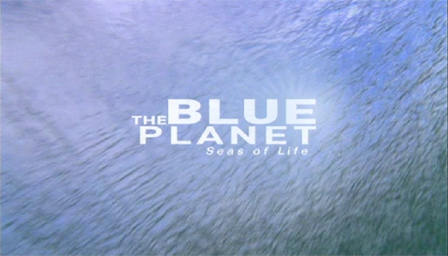
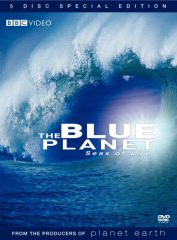 BUY IT AT AMAZON:
BUY IT AT AMAZON: